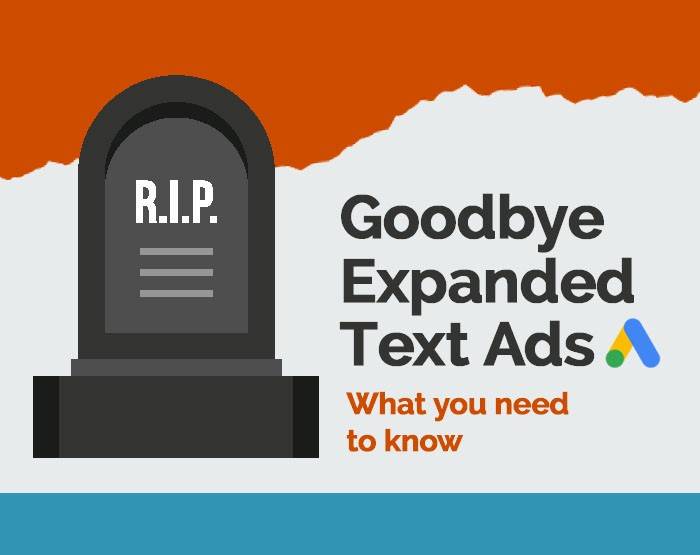June 30th 2022 is a date now circled in the diaries of digital advertisers the world over. This is the date that Google will start to phase out Expanded Text Ads from its PPC advertising options.
As a PPC Agency in Cork, we’ve been using Expanded Text Ads for years to help our clients increase sales. Though the news came as a surprise, it’s not unusual for Google to make changes like this. It’s also not something to be overly concerned about. Google has a well-known track record of making product updates and has never been shy about binning defunct tools. A strategy that has helped to transform marketing and business growth everywhere for the better.
What Are Expanded Text Ads?
Expanded Text Ads is a type of Google Ads tool that was launched originally in 2016. These text-only Search Ads are the type of advertisements that appear at the top of a search result page. In comparison to the previous Search Ads layout, they enabled advertisers to display more detail in their Search Ads (aka PPC). Agencies in Cork, and across Ireland, jumped at the opportunity to test the new advertising choice. We have been using them ever since.
Unlike the original Search Ads which had one headline and one short description, Expanded Text Ads gave advertisers more space. With twice as many characters to use (30 characters for a headline and 90 more for a description) advertisers could say so much more. After much testing and refinements, six years on, Google is retiring Expanded Text Ads in favour of Responsive Ads.

Why Is Google Scrapping Expanded Text Ads?
Google favours progress. They have never been a company to rest on its laurels and instead stay ahead of its competitors by innovating. Rather than keep a product live, they only keep what works best and Expanded Text Ads have had their day.
Three reasons Google is moving away from Expanded text Ads are:
- More than half of Google searches are on mobile devices which means a shift toward mobile-first Ads is vital. Though Expanded text Ads worked for mobile, Responsive Ads work even better.
- Through their research, Google has found that advertisers who switch to Responsive Ads experience a 7% conversion increase.
- Responsive Ads also work best for automation and machine learning which creates more effective ads – more on this below.
At our PPC Agency in Cork, we’re ready for the change and are already using both Expanded Text and Responsive Ads. As a Google Partner, we received an early warning about this change in August so we’re ready for the change. If you have any questions about this or about setting up digital advertising for your business get in touch.
What Exactly Will Happen To Expanded Text Ads On June 30th?
On June 30th this year, Google will put restrictions on its Expanded Text Ads rather than disappearing them altogether. Any existing Expanded Text Ads can continue to be used but it will not be possible to edit them. PPC Agencies setting up new Ads campaigns will not be able to set up new Expanded Text Ads either. There are other brilliant Google Ads options for business advertising though, so this shouldn’t be a problem.
In summary, from June 30th 2022:
- You will not be able to create new Expanded Text Ads on Google.
- You will not be able to edit existing Expanded Text Ads.
- You will be able to run existing Expanded Text Ads.
- You will be able to measure the performance of existing Expanded Text Ads.
- You will be able to move the content of existing Expanded Text Ads to create Responsive Ads.

What’s The Difference Between Expanded Text Ads and Responsive Ads?
Classic Expanded Text Ads show up exactly as they are created. Giving you absolute control over the headline, description and call to action. In 2017, the headlines became longer than past text Ads, as did the description. Expanded Text Ads are used for cross-device campaigns and adapt to different device sizes.
When building an Expanded Text Ad campaign you have a choice of adding three headlines and four descriptions.
Responsive Ads have been around for nearly as long as their Expanded Text Ads sidekicks. However, with ever-changing consumer habits and technological advances, it is responsive ads that have stood the test of time best.
With Google Responsive Ads the clue is in the name. These ads change according to their environment to make sure that they display properly on whichever device or site they appear on. Unlike Expanded Text Ads which were structured as a headline, description and link, Responsive Ads have more options.
To start with, you get to add 15 headline variations, four description options and a URL. The big difference with Responsive Ads is that they do a lot of the work for you. When building a Responsive Ads campaign, you can also add brand or product images of various sizes and videos.
With more content options within the campaign, Google is then able to choose what is best for your audience. It can also select where best to display your content. This means that your Ads campaign can be adapted to suit the display space and to suit the consumer. Responsive ads from one campaign can automatically adjust to display as:
- Text ads on search result pages.
- Visual display ads (image or video) on Google partner sites, including skyscrapers, in-page ads and banner ads.
- Ads that match the native formatting of a web page.
It’s not just the way they display that makes Responsive Ads popular, it’s how they behave too. Google Ads automatically tests different combinations of the content you have uploaded. It then learns which combination gets the best results and promotes those versions ahead of others. This means that your campaigns have Google’s powerful Artificial Intelligence (AI) tools working on your behalf.
Why Does Google Favour AI, Automation and Machine Learning In Advertising?
Before we look at Google’s use of these tools, let’s clarify what they are.
Artificial Intelligence (AI)
Artificial Intelligence (AI) is a technology that mimics human behaviour in order to complete a task. In digital advertising, AI is used to optimise advertising campaigns by displaying advertising and collecting data.
Machine Learning
Machine learning is something that comes from Artificial Intelligence. It is the processing of all the data collected by Artificial Intelligence during a campaign. By analysing this data, Artificial Intelligence learns what works best. When it comes to machine learning for advertising campaigns, the process looks a little like this:
- Advert variations are shown to multiple audiences across devices and platforms.
- The actions and non-actions of those audiences are then analysed.
- The advert variation that receives the most engagement, conversions etc, is then favoured and shown more.
- Further suggestions are sent to the digital advertiser for how to better optimise the advert variations that did not perform as well.
Automation
Automation is the term used to describe the computerised actions of what would otherwise be done manually by a human. In digital advertising, the collection and analysis of data from advertising campaigns are supported by automation. This allows advertisers to understand the behaviours of their audiences and the effectiveness of their campaigns with ease.
Despite its size and dominance in the search engine market share, Google remains ‘user centric’. Google favours AI, automation and machine learning in advertising because it adds to the customer experience. With these tools, Google can ensure that search users are only shown products and services that suit their needs. As these consumers change, so does the Google service that they experience. By keeping customers at the core of what they do, Google retains its place as the largest search engine.
For the advertiser, Google’s use of AI, machine learning and automation means that advertising campaigns are better optimised. This means that they are used in the most effective way possible. Better optimised campaigns mean that your budget and time are used efficiently.
How To Prepare For The End Of Expanded Text Ads
Though this change to Google Ads isn’t a dramatic one it will mean that there is a period of adjustment. Anyone with existing campaigns that rely solely on Expanded Text Ads has an opportunity to experiment before the cut-off date. Here’s how our PPC agency Cork team is preparing.
- We are testing Responsive Ads for all of our Expanded Text Ads campaigns to refine results and future-proof campaigns.
- All campaigns that perform better as Responsive Ads are being transferred from Expanded Text Ads campaigns.
- All campaigns that perform better as Expanded Text Ads campaigns are being fine-tuned before the editing function is removed.
For campaigns that are using Expanded Text Ads with great success, there are ways to mimic them with Responsive Ads. Within the setup of Responsive Ads is a pinning tool that allows advertisers to specify their preferred content. So, for example, if we know that two particular headlines have worked best for a client, we can use these. The same goes for descriptions. By using the pinning tool, you are telling Google your preferences so that content displays as you wish.
There is rarely a year that goes by without Google making changes that send the marketing and advertising industry into a panic. However, to date, there has not been a change that had any detrimental effects. Therefore, even though June 30th will bring change, you can rest assured that Google only makes changes for the better.
A PPC Agency Cork Business Trust
Looking for a PPC Agency in Cork? ePresence Digital Marketing has the digital advertising experience and know-how to help you grow your business. Let us help you get your products and services in front of the right customers. Get in touch today at 021 236 2901 or email info@epresence.ie, to get started.






